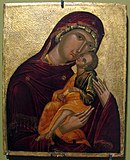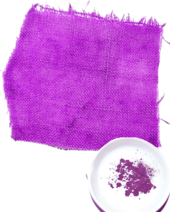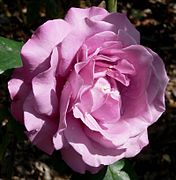Purple (color)
Purple is the general name for shades between red and blue , physically speaking between red and purple .
The color purple therefore corresponds to a color stimulus that excites both the L and S cones . The strongest purple tones are on the purple line of the CIE standard color table , on which all the color tones perceptible to the human eye (with a standardized brightness) are represented.
In the narrower sense, purple or crimson red is a very saturated red-violet or violet-red hue with a "splendid" effect, which goes back to the imperial purple in ancient Rome and Byzantium , and was obtained from the dye of the purple snail .
etymology
The word purple is used neuter or masculine. It goes back to Old High German purpur [a] [female], which comes from the Latin purpura . It is borrowed from ancient Greek πορφύρα porphyra for the dye of the purple snail . The color term “purple” is closely related to this dye, but historically it can also refer to other colors. The reason for this lies in incomplete dyeing processes or counterfeiting of the dye. "It has been attested as a pure color (tone) designation since around 1535." In writing around 1900, the ratio of "purple (n)" to "violet (en)" is 61:42. In the 20th century, the word family purple came into the "upscale poetic". "Purple [is] a word of standard and written language, a word of solemn speech and poetry, [which] points into the area of red without arousing a specific color projection".
In order to Germanize the blue-red color tones, the color characteristic "Veil", derived from violets , was used - for example by Ostwald, but also by Goethe .
The English term purple is not the same as the German word purpur. In the narrower sense, the English purple usually stands for a violet , while the German purple or purple-red in the narrower sense means red-violet or violet-red nuances. In English this corresponds roughly to the term red-violet . One finds “a sample of the purple fabric that was produced in Germany in 1952 for the coronation robes of Queen Elisabeth II: it is a 'warm dark red that plays into violet', which is used in German. is typically written as crimson , but was named coronation-red in English . But also in English the boundaries between purple […] violet, mauve, lilac are fluid. French pourpre remains dependent on the interpretation. "
Color theory
By definition, purple is the color range of all shades of the purple line between the color stimuli of the longest-wave visible spectral red (L cone) and the shortest-wave visible spectral violet (S-cone). The spectral color violet is perceived with emission from 380 to about 420 nanometers. In the chromaticity diagram, purple is found at the blue end of the curve at (x; y) = (0.17; 0).
By definition, there is no spectral color purple, beyond blue there is violet, which leads to ultraviolet. There is disagreement about the assignment to the purple tones. This can have its cause in individual variations in perception, in particular because color stimuli act on the edge of the visible.
The designation of various shades between blue red and red blue is only vaguely defined, especially since the spectral color violet is perceptually similar. The delimitation of the “blue-red hues”, including purple, is difficult and is subject to individual and cultural-historical assessments. The shades are related to purple:
- Indigo , a blue that is close to the violet in the spectrum
- Fuchsin, the shade of the fuchsia
- Magenta , a basic color of the CMYK color model
- lavender, violet
- pink
- plum-colored , a concept of fashion, in the breadth of variations of the fruit
- orchid colors , a term in the fashion industry, at Netscape: DA 70 D6
- Mauve , mauve; the first synthetic tar color was mauvein.
In common parlance, violet and lilac are often used instead of purple, more violet than purple, the latter being known through its use in the primer and thus displaced from the standard language.
Clarification of color names is fully with color systems possible, such as the Web colors , the RAL system or color catalogs, such as NCS or Pantone - color fan .
The color valence purple results from the additive mixture of the colored lights red and blue . With the additive color mixing of the RGB color space , i.e. with light colors , light purple is the mixing result of the primary colors orange-red and blue-violet and is thus itself a secondary color . With the subtractive color mixing of the CMYK color space , on the other hand, the purple shade “magenta” is a primary color.
| purple | Purple |
Medium purple red |
Pale purple red |
Dark magenta |
Fuchsia magenta |
Dark pink |
Dark purple |
violet |
Blue- violet |
indigo |
|---|
RAL colors
In the RAL color system , the colors RAL 3004 purple red and RAL 4006 traffic purple are defined. RAL 3004 purple red was used by the Deutsche Bundesbahn from the beginning of the 1950s to the mid-1970s for diesel locomotives , sleeping cars and dining cars and until the end of the 1980s for the lower range of Trans-Europ-Express and InterCity vehicles (1st class and Dining car) and faster electric locomotives were used.
Historical use


Definition
The meaning of the term purple has changed over the course of history. Until well beyond the Middle Ages , it was not always necessary to define the color exactly. Sometimes it was also named after the origin or the cultural meaning of the coloring component.
The evangelists Markus ( Mk 15.17 EU ) and John ( Joh 19.5 EU ) refer to the mocking cloak mentioned in the descriptions of the crucifixion of Christ as ancient Greek πορφυροῦς 'purple' , while Matthew ( Mt 27.28 EU ) call it ancient Greek κοκκίνην ' scarlet ' describes.
Manufacturing
The real purple dye is one of the most expensive dyes in the world. It is obtained from various purple snails (especially haustellum brandaris and haustellum trunculus ) and colors fabrics green, dusky pink, deep red, blue, purple or almost black, depending on the type of snail, sex, diet and the duration of the individual coloring process. This almost black or deep dark purple purple was called Tyrian purple , and was the result of the longest dyeing process, with the addition of copious snail secretions. Therefore it was particularly valuable and was later used in Byzantium mainly for imperial clothing. In the Mediterranean area, where the animals were killed to obtain color, the Phoenicians were the main producers of the color in antiquity .
Among the Mixtecs in Central America , the purple snails were "milked" and then put back alive on the rocks. This technique has been handed down to this day.
history
In ancient Rome , purple was reserved for togas and, for a time, only for the sashes of senators . It was the dye of the toga of triumphators and the emperor. A probably relatively realistic impression of the color tone of the imperial purple in Rome is given by some ancient statues , whose robes are made of dark porphyry .
Since the early Middle Ages, the main suppliers of the coveted purple products were based in the city of Constantinople . Here, too, purple was reserved for the emperors .
From the 4th or 5th century, valuable manuscripts were written on purple-dyed parchment . Gospel and other biblical texts have been preserved. Since the 10th century, special documents have been written on purple-colored parchment, mostly copies of papal agreements for the recipients. However, the original purple color of the parchment has now mostly changed to brownish after hundreds or over a thousand years, just as the silver ink used is oxidized and now appears black.
Later, the color was reserved within the Catholic Church for the cardinals , who are therefore also called "purple bearers", although the color of their official costume is a bright scarlet red . The term goes back to the purple coat (no longer used today), which Pope Paul II introduced in 1464 as a garment for cardinals. Although not dyed with purple, the purple of the Roman Catholic bishops' robes is similar in color .
From the early modern period, the dye was increasingly replaced by cheaper, but very similar in color, dyes that were already known in the Roman Empire.
symbolism

The symbolic meaning of the color purple is partly derived directly from the preciousness of the dye and its historical use and stands for imperial-royal as well as priestly-divine dignity, power and majesty. Above all, the dark color of the noble Tyrian purple was associated with “the greatest glory” by Pliny , but also compared with (clotted) blood by Homer . In Christianity, purple also stands for humility and penance and is the color of Passion and Advent (today purple).
All these meanings flow together in the fact that in the icon painting of Byzantium and in the Eastern Church traditionally the Blessed Virgin Mary was and is mostly depicted in a dark purple coat (often over a blue dress) (sometimes also in dark red).
heraldry
Heraldically and vexillologically , the designation “ purple ” is always only this single standard color, regardless of the specific rendition of the color tones, which differs in individual cases. Purple is one of the classic tinctures and colors .
gallery
- Purple in nature
Orchid Epidendrum secundum
Clematis 'Voluceau'
Chess flower ( Fritillaria meleagra )
pale purple rose 'Royal Amethyst'
Dahlia in purple and white
Rosa gallica 'Charles de Mills'
Natural objects in purple
- Purple willow
- Purple agate apple
- Purple apple (also blood apple)
- Purple beech
- Purple gentian
- Purple Grackle
- Purple carnation
- Purpurite
- Purple clover
- Purple orchid
- Purple magnolia
- Purple dead nettle
- Crimson Cousinot (apple variety)
- Purple moth (butterfly)
- Purple onion apple
- Purple sun hat
- Purple fir
- Flame color of the chemical element rubidium
Web links
- Manfred Breitmoser: purple. Color phenomenon of antiquity, purple manuscripts.
- Purple in the dictionary of dyes
- Clothing - cardinal purple on kath.de
- Purple: Color from the sea on farbimpulse.de, September 15, 2004
- Inge Boesken Kanold: 36010 Purple - the color of the emperors. In: Pharmaceutical newspaper. 145, No. 16, April 20, 2000.
Individual evidence
- ^ Frederic C. Mish (Editor): Webster's Ninth New Collegiate Dictionary. Merriam-Webster, Springfield 1983, ISBN 0-87779-508-8 , p. 957.
- ^ Purple in the dictionary of dyes
- ^ A b William Jervis Jones: Historical Lexicon of German Color Designations. Volume IV, Frühneuhochdeutsch Neuhochdeutsch-L-R . Akademie Verlag, Berlin 2013, ISBN 978-3-05-005953-2 .
- ↑ Extensive documentation on these questions can be found under the relevant keywords in William Jervis Jones: Historisches Lexikon deutscher Farbbezeichen , Akademie Verlag / De Gruyter, Berlin 2013.
- ↑ RAL Institute ( Memento from July 4, 2008 in the Internet Archive )
- ↑ Pantone catalog: GoeGuide uncoated (English)
- ↑ Netscape color names (120 additional colors) in SELFHTML
- ↑ Often only the purple-clad porphyry body has been preserved. In some cases the head, hands and possibly feet were added later, e.g. B. in a seated Minerva figure from the 2nd century BC. In the Louvre (Paris), the gilded bronze head and arms of which were added around 1700 (see illustration). Similar cases are: a Minerva statue on Capitol Square in Rome, which was supplemented in 1589 with white marble for the "goddess Roma"; also an ancient statue in the Archaeological Museum in Naples, which only became a "Kithara-playing Apollo" in the 19th century.
- ↑ a b c J. C. Cooper: Illustrated Lexicon of Traditional Symbols , Drei-Lilien-Edition / Seemann Verlag, Wiesbaden (undated), p. 51
- ↑ The already dark purple color of very old icons is due to soiling from soot or the like. sometimes difficult to recognize today. André Deguer: Ikonen , Berghaus Verlag, Ramerding, 1977, p. 20 (sooting), Fig. 1 (?), 2–23, 31, 44, 51













